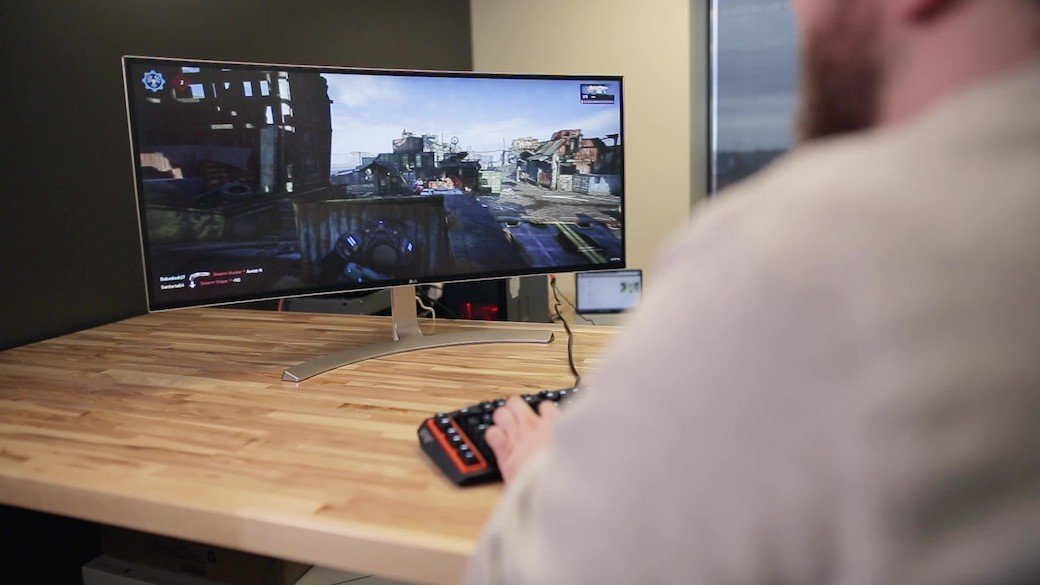An ultrawide monitor is a rectangular display with the proportions of a movie theater screen. If you are an avid gamer, creative professional, or someone who needs to multitask between two computer screens, an ultrawide monitor may be the best choice for you.
With so many ultrawide monitors available from major manufacturers such as Dell, Samsung, and Alienware — each with its own unique set of features, screen resolution, and specs — it can be difficult to determine which one belongs on your desktop. There are a few key tips to keep in mind when comparing various ultrawide monitors to make the search a bit easier.

What to consider when shopping for an ultrawide monitor
Resolution
Simply put, an ultrawide monitor’s resolution is measured by how many pixels make up its screen, and displays sporting a higher resolution feature smoother movement, a deeper contrast ratio between dark and light tones, and a wider color gamut. The most common resolutions available for ultrawide monitors are Full-HD (1080p), QHD (1440p), QHD+ (between 1440p and 4K), and the occasional 4K monitor.
Thrifty viewers can save a bit of money by purchasing an ultrawide monitor with a lower resolution. However, if you intend to buy a model for high-end gaming or watching streamed movies, a monitor with an especially high resolution is worth the investment for its accurate colors and superior picture quality.
Refresh rate
While the refresh rate of an ultrawide monitor is not the biggest factor for the average buyer, it may make all the difference for video game players. In a nutshell, a computer monitor’s refresh rate refers to how many times an image is displayed on screen per second.
A relatively lower refresh rate of 100 Hertz (Hz) is more than acceptable for web browsing, typing, and other basic tasks, but if you are buying an ultrawide monitor for PC gaming, you should not settle for anything less than a model with a 144Hz refresh rate. Premium gaming monitors are designed for a high refresh rate of up to 240Hz, providing consistently smooth visuals — especially for anyone who prefers to play online.
Screen size
An ultrawide monitor is larger than the average computer monitor by default, but if you want to get the most out of your new display, bigger is always better. Ultrawide monitors are available anywhere from 29 inches to over 49 inches, and while the extra-wide giants are especially pricy, they are usually loaded with the latest features and higher resolutions that are unavailable for their smaller counterparts. If you do not have space for a huge monitor setup or have no need for premium gaming features, it may be worth seeking out a more affordable ultrawide monitor.
Ports
Buying an ultrawide monitor with a wide variety of ports improves the chance that you will be able to easily plug and play a new device to your PC at a moment’s notice. For maximum connectivity, ultrawide displays should include one or more HDMI ports, USB-C ports, Thunderbolt 3 ports, and a DisplayPort.
Some users prefer to install a VESA mount to connect their ultrawide monitor to the wall as an ergonomic solution or to free up space on their desktop. If you plan on buying a VESA wall mount, double check to ensure it will fit your new ultrawide monitor before you buy.
HDR
Seeking out a high-resolution ultrawide monitor is a worthwhile investment for anyone who regularly plays PC games or watches streaming apps, but a model that features HDR support is even better. HDR is a display technology that presents lifelike levels of color and stark contrast levels between bright and dark tones for a crystal-clear and detail-rich picture.
Once you watch your favorite show or play your favorite video game with HDR enabled, you may find it difficult to go back to standard dynamic range. Keep in mind that an ultrawide monitor’s compatibility with HDR is often noted in different ways in its feature list, such as DisplayHDR or HDR10.
